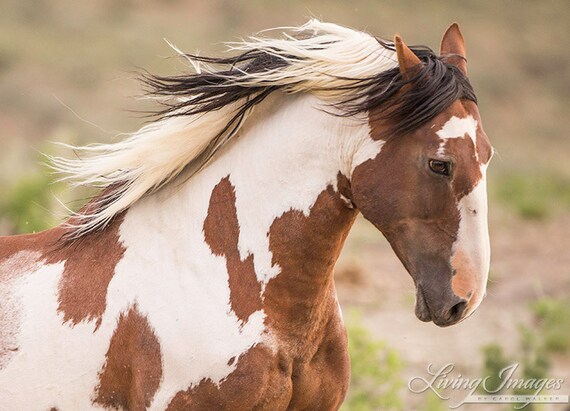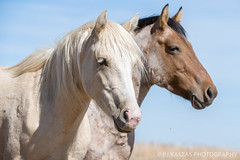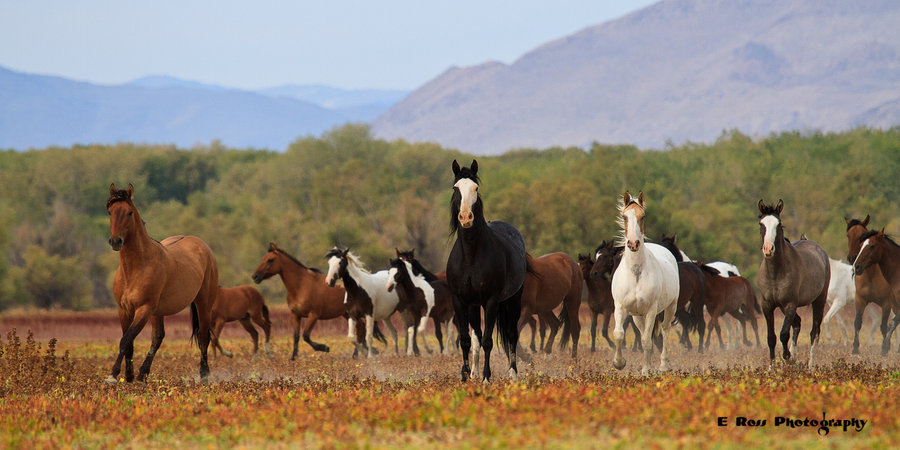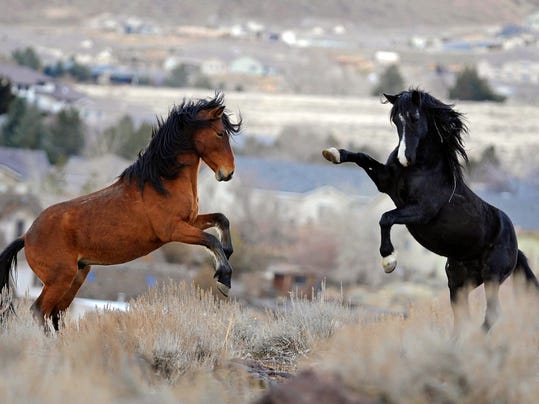There is a battle going on in the U.S. that many people are unaware of. Perhaps they think that it’s unimportant, or that it doesn’t affect them. The battle to save America’s wild Mustangs is not just a battle between soft-hearted horse lovers and hard-working ranchers. It’s much more complex than that. And in the end, we could all lose.
Every year, the Bureau of Land Management, or BLM for short, rounds up (or "gathers" up) and removes between 5,000 - 10,000 (but often more) wild Mustangs and places them in government holding in the hopes that they will be sold or adopted. This is done to prevent overpopulation (because Mustangs' natural predators are hunted by humans), and therefore to prevent habitat degradation and wild horses encroaching on private land/threatening ranchers. These are very good reasons to want to manage wild horses, but as you will see, there are major problems with how the BLM does this.
The realities of BLM removals:
BLM helicopter roundups are inhumane.
Around 2 years ago, the BLM conducted a roundup that was just like any other. During that roundup, a newborn foal was unable to keep up with the breakneck speed at which the helicopter drove his herd. To get him out of the way, BLM employees
hog-tied him and left him out on the range, planning to come back for him.
They forgot about him. When they came back the next day,
the newborn had died from dehydration and heatstroke out in the desert sun.
“Oh well,” BLM employees said.
“These things happen.” Unfortunately, this little newborn’s story is not at all uncommon. A similar incident took place in 2012 during the
Desatoya Wild Horse Gather near Austin, Nev.
A BLM employee was witnessed hogtying a young foal and leaving it in the path of stampeding wild horses.
Before they are put into the holding pens, these large, frightened,
wild-minded animals are
forced through tight structures called “squeeze chutes.” If a horse trips and falls, it is trampled, and horses in the front of the line are often smashed against the fences by the panicking horses behind them. Many have their
necks and legs broken in the chutes.
Wild horses react very badly to being suddenly confined by what they understand to be two-legged predators. They panic, kicking, jumping, stampeding, and screaming. Stallions (and sometimes mares) perceive domestic BLM horses as threats to their herds, and this has resulted in deaths and injuries for both wild and domestic horses.
Take the Silver King stallion, Braveheart, for example. Braveheart mistook a BLM horse tied outside his corral as a threat to his mares and foals, and proceeded to attack the horse, breaking his neck and dying in the process.
The wild stallion called Freedom is another example. This black stallion leaped a six-foot-tall fence and charged full-on through barbed wire (violently shredding his skin) in his mad dash for freedom.
BLM helicopter roundups are expensive.
BLM helicopter roundups are ineffective/counterproductive.
Roundups are also an ineffective way to keep wild horses from overpopulating.
According to the National Academy of Sciences, removing horses from the range causes population growth, which is what the BLM hoped roundups would fix. (Pro-roundup people make the claim that I am taking the NAS out of context and/or that the NAS never actually said this, but you can read everything they wrote, and you will see exactly what I’ve said. To quote the NAS directly:
“The U.S. Bureau of Land Management’s (BLM) current practice of removing free-ranging horses from public lands promotes a high population growth rate, and maintaining them in long-term holding facilities is both economically unsustainable and incongruent with public expectations, says a new report by the National Research Council.” Why would the NAS lie about what they have said? They wouldn’t. The only people who are lying about what the NAS said are pro-roundup people.)
When horses are removed from the wild, the ones left in the wild reproduce at a faster rate. The species springs back as it would after a natural disaster or a plague. The National Academy of Sciences and the BLM estimate that
the population growth is about 20%, which means that Mustangs can double their population in less than 5 years. In some places it’s reached the point where
wild horses are starving and/or are
causing habitat damage. But instead of removing just starving and damaging herds,
the BLM uses those starving herds as an excuse to increase roundups nationwide, which is costly, removes genetic information from the herds, and does not help the starving herds.
The BLM has also been known to use calls for help from ranchers to remove wild horses from land miles away from ranchers, which, again, is costly, removes genetic information from the herds, and does not help ranchers.
To keep the horses from starving or causing environmental damage, more horses must be removed each year and put into the already overcrowded holding pens. If the BLM continues its “business as usual,” the financial cost for wild Mustang removals will increase at about 20% each year, and we will be the ones to pay for it.
PZP: A humane, inexpensive, and effective management option.
So, because their predators are hunted by humans (and we simply can’t release a horde of mountain lions, wolves, and bears into ranchers’ lands) wild Mustangs need to be managed, but is there a way to do it humanely, effectively, and at a low cost? Yes, there is!
Some people might suggest that the government just legalize a wild horse hunting season to manage Mustangs, but hunting has never worked to manage them (hunting Mustangs used to be legal, but so many were killed that they needed an act of Congress - the Wild Horse and Burro Act of 1971 - to save them from extinction). If we try to use hunting to manage them again, in about 70 years we’ll be right back where we are now. Do we want to deal with the problem now or later?
What is PZP?
To quote Dr. Jay F. Kirkpatrick: There’s a cultural hangover in the west — I’ve been told, “no, we don’t do things that way [with fertility control], we use ropes and horses.” It’s also an economic issue: there are a few families in the west that are contracted to make millions on the wild horse roundups. Concerns have been raised over taking away those families’ revenue. And of course, the politicians follow the economy.
There’s also a polarization effect: wild horse advocacy groups originally opposed the use of PZP. Eventually, they came to realize that they had three choices: they could watch the horses starve to death on the range, they could continue to see them rounded up and removed, or they could start to use fertility control. They saw that they really only had one choice. And because the advocacy groups now support the use of the vaccine, the BLM opposes it — they don’t want to agree with what they perceive to be [wild horse] radicals.
PZP can be delivered through darts, so the horses don’t need to be rounded up.
Wild horses will not need to endure the brutal roundups described above. PZP can be administered in a number of ways: horses can be rounded up, given the vaccine and then released; horses can be enclosed with food and water baiting (not rounded up), given the vaccine through darting or injection and then released; or horses can be darted individually out on the range. The last two options are the most humane.
The effect of PZP is temporary, so it does not damage the gene pool. Mares that are darted or injected with PZP are rendered infertile for 1-3 years (depending on if a dart or injection was used), so the overall population growth in reduced, but all mares can have foal(s) at some point in their lives, thus ensuring that the gene pool remains diverse and healthy. It effectively curbs population growth without causing stress, injuries, or inbreeding.
Has PZP been used to manage wild horses before?
Yes, and every single experiment with PZP on wild horses has been a success and has saved an estimated millions of dollars. Naturally, PZP works better in some environments and HMAs better than others, but in every case, it has worked quite admirably. To name just two such instances:
Are there any cons to PZP use?
The only problem with PZP use is the unknown. PZP has never been used large-scale on a population of animals in several states. The BLM and NAS are concerned that it may be difficult to keep track of which horses have been darted/injected and which have not. Unfortunately, the only way to find out is to try it. The BLM could very easily hire or allow volunteers to keep track of the horses for them. Organizations such as the Cloud Foundation abound, are present at every HMA, and would be more than happy to help the BLM conduct a humane management option. PZP is NOT out of the BLM’s reach.
Animal rights activists have fought against PZP, claiming that wild horses should not be managed at all and that darting them would be cruel, but it's clear that they do need to be managed, and it's cruel to have them starve out on the range. Unless we can find a way to release predators into the wild without harming people, then yes, wild Mustangs need to be managed.
Pro-roundup people will once again take quotes from members of the NAS out of context to make it sound as if the NAS does not approve of PZP use. However, you are free to read their book for yourself, and you will see that the NAS very clearly advocates PZP. To quote the NAS: "To manage horse populations without periodic removals, widespread and consistent application of fertility control would be required, the committee determined. Three methods in particular -- porcine zona pellucida (PZP) and GonaCon™ for mares and chemical vasectomy for stallions -- were identified as effective approaches." That is literally the NAS's exact words. Why would the NAS lie about what they said in their own book? Obviously, the only lying people here are pro-roundup folks, not the NAS.
PZP has been blamed for out-of-season foal births, but those claims are false. Those statistics are counted only in treated herds. You’ll find exactly the same results in untreated herds, but nobody is counting those.
What no one mentions is that foals born out-of-season to treated mares have a greater chance of survival than foals born out-of-season to mares who haven’t received the vaccine. That’s because treated mares are more robust, in better health, and much better able to take care of a foal through the challenges of winter. Producing a foal every year taxes a mare’s body; when she is producing one foal only every few years the mare is much healthier.
Assateague Island is a great example. Prior to the use of PZP on the pony herds, no mare ever lived to the age of 20. The mean age of death in the wild was seven years. We’ve been using contraception on the island for 30 years: now the mean age of death is 26 and there are mares in their 30s. The body condition of those mares has greatly improved, and herd levels remain at a manageable number for what the land can support.
PZP would save the U.S. government millions of dollars.
Let's review the benefits of PZP...
1) Taxpayers and the BLM would benefit. Taxpayers would not need to give as much to fund the Wild Horse and Burro Program, and the BLM would be able to use its extra money to help find environmentally-friendly oil drilling opportunities, to help protect wildlife, and to manage cattle grazing.
2) Wild Mustangs would benefit. Horse would not need to face the brutal roundups currently in practice today, and the BLM would not need to remove as many horses from the wild (if any), so they would be more able to find homes for the horses already in their care.
3) Ranchers and the environment would benefit. There would be less population growth of wild horses, and thus they would be less likely to cause environmental damage or threaten ranchers.
 Meet Cloud, the famous wild stallion of the Pryor Mountains in Wyoming
Meet Cloud, the famous wild stallion of the Pryor Mountains in Wyoming. Cloud’s life has been documented from the day of his birth in 1996. Experimental PZP use in Cloud’s herd has enabled him and many of his offspring to live nearly their entire lives in the wild. However, many of his family members have not been as lucky and have been removed by the BLM through either helicopter stampedes or bait trapping operations. In the spring of 2011, Congress declared Cloud an
ambassador for all wild horses living in the American West.
 This handsome stallion is Picasso
This handsome stallion is Picasso, the patriarch of the Sand Wash Basin in Colorado. Picasso is perhaps one of the most photographed wild Mustangs, and he has also endured and escaped many roundups in his long life over 20 years.
 This is Champ, a gray stallion
This is Champ, a gray stallion from the Salt River in Arizona. Champ shot to fame after tourists photographed him leaping into a river to rescue a young filly from drowning. The wild horses of the
Salt River are the source of much controversy, as they are eating cottonwood seedlings. However, they are also doing several good things for the land, such as eating eel grass that would otherwise clog the river. The Salt River horses have also been in that exact area for over 500 years, so either their effect on cottonwood seedlings is not as drastic as it looks, or something has forced them to change their behavior. If something has made them change their behavior, that problem should be addressed. Removing all the Salt River horses is clearly not the answer.
 These two lovebirds are Knight and Encore
These two lovebirds are Knight and Encore, a mare and stallion from the Arrowhead Mountains. For several years, Knight and Encore have been inseparable. Knight doesn’t want other mares, he’s content with just Encore, and fights to defend her from mare-stealing bachelor bands. If he fails and Encore is stolen, he simply waits for her to return to him, and she always does. Knight and Encore are one of several herds along the Wyoming-Montana border that are scheduled for removal. If the BLM goes through with this, they will be separated. Knight will be castrated. They will most likely never see each other ever again.
In Conclusion...
If the goal is to manage wild horses so as to keep them safe and healthy, harmless to ranchers and the environment, and free in the wild, then PZP is the answer. In the end, it really just comes down to whether or not the BLM is willing to try something new. Do they care more about doing their job to the best of their ability or just carrying on “business as usual”? Are they willing to think long-term or only consider what’s directly in front of them? And we must also ask ourselves whether we are willing to show compassion towards these animals.








 Meet Cloud, the famous wild stallion of the Pryor Mountains in Wyoming. Cloud’s life has been documented from the day of his birth in 1996. Experimental PZP use in Cloud’s herd has enabled him and many of his offspring to live nearly their entire lives in the wild. However, many of his family members have not been as lucky and have been removed by the BLM through either helicopter stampedes or bait trapping operations. In the spring of 2011, Congress declared Cloud an ambassador for all wild horses living in the American West.
Meet Cloud, the famous wild stallion of the Pryor Mountains in Wyoming. Cloud’s life has been documented from the day of his birth in 1996. Experimental PZP use in Cloud’s herd has enabled him and many of his offspring to live nearly their entire lives in the wild. However, many of his family members have not been as lucky and have been removed by the BLM through either helicopter stampedes or bait trapping operations. In the spring of 2011, Congress declared Cloud an ambassador for all wild horses living in the American West. This handsome stallion is Picasso, the patriarch of the Sand Wash Basin in Colorado. Picasso is perhaps one of the most photographed wild Mustangs, and he has also endured and escaped many roundups in his long life over 20 years.
This handsome stallion is Picasso, the patriarch of the Sand Wash Basin in Colorado. Picasso is perhaps one of the most photographed wild Mustangs, and he has also endured and escaped many roundups in his long life over 20 years. This is Champ, a gray stallion from the Salt River in Arizona. Champ shot to fame after tourists photographed him leaping into a river to rescue a young filly from drowning. The wild horses of the Salt River are the source of much controversy, as they are eating cottonwood seedlings. However, they are also doing several good things for the land, such as eating eel grass that would otherwise clog the river. The Salt River horses have also been in that exact area for over 500 years, so either their effect on cottonwood seedlings is not as drastic as it looks, or something has forced them to change their behavior. If something has made them change their behavior, that problem should be addressed. Removing all the Salt River horses is clearly not the answer.
This is Champ, a gray stallion from the Salt River in Arizona. Champ shot to fame after tourists photographed him leaping into a river to rescue a young filly from drowning. The wild horses of the Salt River are the source of much controversy, as they are eating cottonwood seedlings. However, they are also doing several good things for the land, such as eating eel grass that would otherwise clog the river. The Salt River horses have also been in that exact area for over 500 years, so either their effect on cottonwood seedlings is not as drastic as it looks, or something has forced them to change their behavior. If something has made them change their behavior, that problem should be addressed. Removing all the Salt River horses is clearly not the answer. These two lovebirds are Knight and Encore, a mare and stallion from the Arrowhead Mountains. For several years, Knight and Encore have been inseparable. Knight doesn’t want other mares, he’s content with just Encore, and fights to defend her from mare-stealing bachelor bands. If he fails and Encore is stolen, he simply waits for her to return to him, and she always does. Knight and Encore are one of several herds along the Wyoming-Montana border that are scheduled for removal. If the BLM goes through with this, they will be separated. Knight will be castrated. They will most likely never see each other ever again.
These two lovebirds are Knight and Encore, a mare and stallion from the Arrowhead Mountains. For several years, Knight and Encore have been inseparable. Knight doesn’t want other mares, he’s content with just Encore, and fights to defend her from mare-stealing bachelor bands. If he fails and Encore is stolen, he simply waits for her to return to him, and she always does. Knight and Encore are one of several herds along the Wyoming-Montana border that are scheduled for removal. If the BLM goes through with this, they will be separated. Knight will be castrated. They will most likely never see each other ever again.

No comments:
Post a Comment